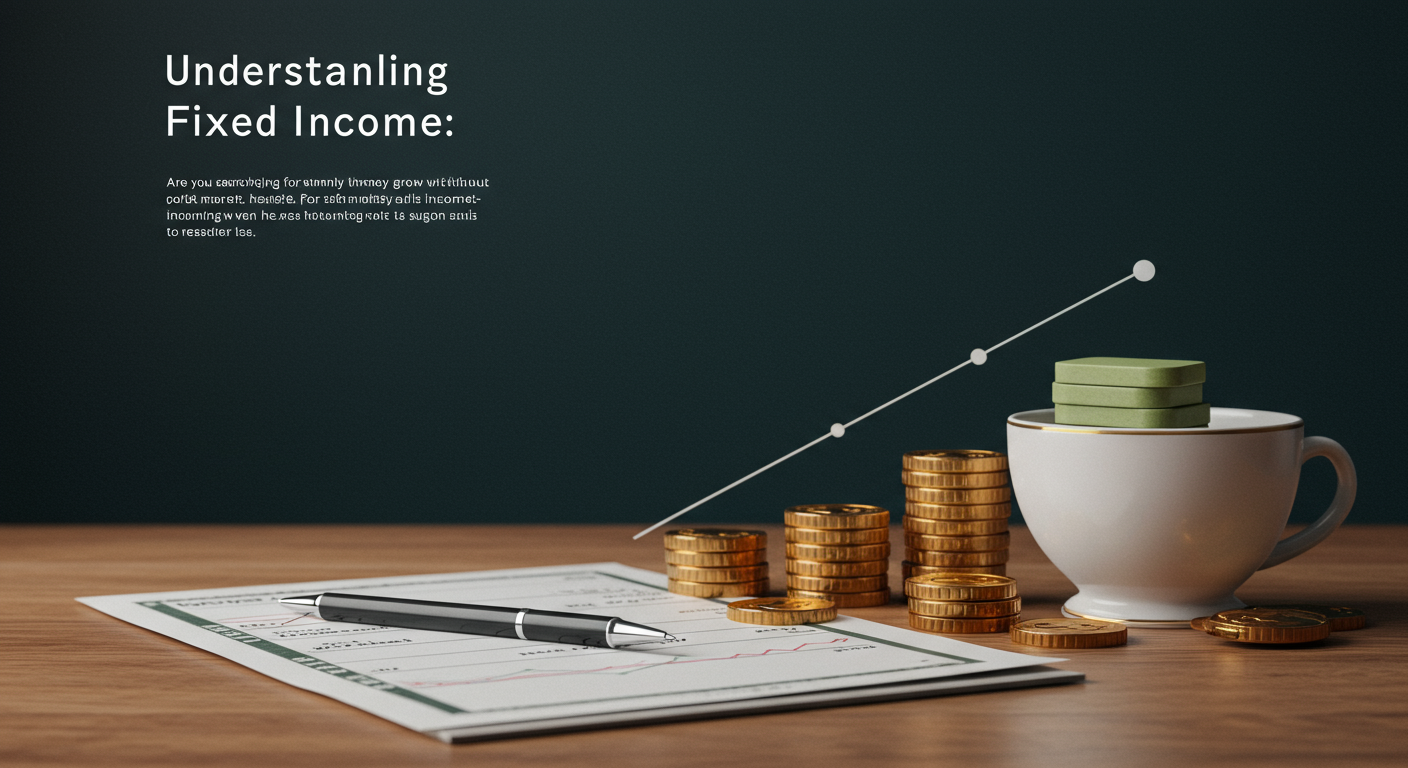Understanding Fixed Income: A Safe Option for Your Investments
Are you searching for a way to make your money grow without the intense volatility of the stock market? For many investors, the key to building a resilient portfolio lies in understanding and utilizing fixed income. This investment class offers a compelling combination of stability, predictability, and capital preservation. If you want to secure your financial future with a more conservative approach, or simply balance out higher-risk assets, then this guide is for you. We will demystify fixed income, explore its core components, and show you how it can serve as a foundational element in your investment strategy.
Fixed income investing is often misunderstood as being overly complex or only for institutional players. However, the reality is that it is an accessible and powerful tool for the individual investor. This article will provide you with clear, actionable information to help you navigate this essential part of the financial world.
What Exactly Is Fixed Income?
At its core, a fixed income investment is essentially a loan. When you buy a fixed income security, you are lending money to an entity, which could be a government, a municipality, or a corporation. In return for your loan, the issuer promises to pay you periodic interest payments—the income—over a specified period. At the end of that period, known as the bond’s maturity date, the issuer repays the original amount of the loan, which is called the principal.
Think of it this way: you are acting like a bank. The interest payments are your reward for lending out your capital, and they are typically fixed, meaning the rate does not change. This predictability is the main attraction of fixed income assets, as it provides a steady and reliable stream of cash flow, unlike the fluctuating dividends and prices associated with stocks.

The Main Types of Fixed Income Assets
The world of fixed income is diverse, with various instruments tailored to different needs and risk appetites. Understanding the primary types is the first step toward building a well-rounded portfolio. Here are some of the most common categories:
- Government Bonds: These are debt securities issued by a national government to finance its spending. They are widely considered to be among the safest investments because they are backed by the full faith and credit of the government, which can raise taxes or print money to repay its debt. Examples include Treasury Bills (T-bills), Treasury Notes (T-notes), and Treasury Bonds (T-bonds), which differ primarily in their maturity periods.
- Corporate Bonds: Companies issue corporate bonds to raise capital for expansion, operations, or other business needs. Their level of risk depends heavily on the financial health and stability of the issuing company. Credit rating agencies (like Moody’s and S&P) assess this risk, assigning ratings that help investors gauge the likelihood of default. Higher-rated bonds are safer but offer lower interest rates, while lower-rated (or high-yield) bonds offer higher rates to compensate for increased risk.
- Municipal Bonds: Often called munis, these are issued by states, cities, or other local government entities to fund public projects like schools, highways, and hospitals. A key advantage of municipal bonds is that the interest income is often exempt from federal taxes and sometimes from state and local taxes as well, making them particularly attractive to investors in higher tax brackets.
- Certificates of Deposit (CDs): While technically a savings product, CDs function like fixed income investments. You deposit a sum of money with a bank for a fixed term, and in return, the bank pays you a fixed interest rate. Your principal is very safe, as CDs are typically insured by government-backed agencies up to a certain limit. For more details on various options, explore our section on Financial Products.
The Key Benefits of Investing in Fixed Income
Incorporating fixed income into your overall Investment strategy can provide several significant advantages. It is not just about avoiding risk; it is about building a smarter, more balanced financial plan. Here are the primary benefits:
- Predictable Income Stream: The name says it all. Fixed income provides a regular and predictable source of income through its coupon payments. This can be especially valuable for retirees or anyone who relies on their investments for living expenses. Knowing how much money you will receive and when can make financial planning much simpler.
- Capital Preservation: Compared to equities, fixed income securities are generally focused on preserving your initial investment. While no investment is entirely without risk, high-quality government and corporate bonds have a very low probability of default. This makes them a cornerstone for conservative investors whose primary goal is to protect their principal.
- Portfolio Diversification: This is perhaps one of the most important roles of fixed income. The prices of bonds and stocks often move in opposite directions. During periods of economic uncertainty or stock market downturns, investors tend to flock to the safety of bonds, which can help stabilize your portfolio’s overall value. A mix of asset classes reduces your dependence on any single one, leading to smoother long-term returns.
- Lower Volatility: The financial markets can be a turbulent place. Fixed income assets generally exhibit much lower price volatility than stocks. This stability can provide peace of mind and help you stay invested for the long term, avoiding emotional decisions driven by market swings.
Understanding the Risks Associated with Fixed Income
While fixed income is considered a safe haven, it is essential to be aware that it is not entirely risk-free. A savvy investor understands both the pros and cons. The primary risks to consider are:
Interest Rate Risk: This is the most significant risk for bondholders. If prevailing market interest rates rise after you purchase a bond, new bonds will be issued with higher yields. Consequently, your existing bond with its lower fixed rate becomes less attractive, and its market value will decrease. If you hold the bond to maturity, you will still get your principal back, but if you need to sell it beforehand, you may have to do so at a loss.
Inflation Risk: This is the risk that the rate of inflation will rise above the fixed interest rate of your bond. If your bond pays 3% interest but inflation is running at 4%, your investment is actually losing purchasing power over time. Your money is growing, but its ability to buy goods and services is shrinking. Long-term bonds are particularly susceptible to this risk.
Credit Risk (or Default Risk): This is the risk that the bond issuer will be unable to make its promised interest payments or repay the principal at maturity. This risk is negligible for major government bonds but is a real consideration for corporate and some municipal bonds. Always check the credit rating of a bond before investing to assess the issuer’s financial strength.
How to Add Fixed Income to Your Portfolio
Getting started with fixed income is more accessible than ever. You have a few main avenues to consider:
Direct Purchases: You can buy individual bonds directly through a brokerage account. This approach gives you maximum control, as you can select specific bonds with maturity dates and credit quality that align perfectly with your financial goals. However, it requires more research and often a larger initial investment to achieve proper diversification.
Bond Funds and ETFs: For most individual investors, bond mutual funds or exchange-traded funds (ETFs) are the most practical option. These funds hold a diversified portfolio of hundreds or even thousands of different bonds. This instantly spreads your risk across many issuers, sectors, and maturities. They also offer professional management and are easy to buy and sell, making them a convenient, low-cost way to gain exposure to the fixed income market.
Ultimately, the right approach depends on your personal financial situation, your tolerance for risk, and your investment timeline. For personalized advice, it is always wise to consult with a financial professional who has demonstrable experience in portfolio management.
Conclusion
Fixed income is an indispensable component of a well-constructed investment portfolio. It offers a powerful combination of predictable income, capital preservation, and valuable diversification that can anchor your finances against the storms of market volatility. While it comes with its own set of risks, such as interest rate and inflation risk, a clear understanding of these factors allows you to mitigate them effectively.
Whether you choose to invest through individual bonds or diversified funds, embracing fixed income is a strategic move toward building a more stable and resilient financial future. It provides the balance needed to pursue growth while protecting what you have already earned, putting you on a firmer path to achieving your long-term financial goals.
Frequently Asked Questions (FAQ)
Is fixed income completely risk-free?
No investment is completely free of risk. While fixed income is generally much safer than stocks, it is subject to risks like interest rate risk (the value of your bond may fall if market rates rise), inflation risk (your fixed return may not keep pace with inflation), and credit risk (the issuer could default on its payments). High-quality government bonds have minimal credit risk, but all bonds are affected by interest rate and inflation changes.
What is the main difference between a bond and a stock?
The fundamental difference lies in what you own. When you buy a bond (a fixed income asset), you are lending money to an entity and become a lender. You are entitled to fixed interest payments and the return of your principal. When you buy a stock, you are purchasing a small piece of ownership in a company and become a shareholder. Your return comes from potential stock price appreciation and dividends, which are not guaranteed and carry higher risk but also offer higher potential for growth.
How can I start investing in fixed income?
The easiest way for most people to start is through a standard brokerage account. From there, you have two main options: 1) Purchase bond exchange-traded funds (ETFs) or mutual funds, which offer instant diversification by holding a wide variety of bonds. 2) Buy individual bonds directly, which gives you more control but requires more research and capital to diversify properly. For beginners, bond funds are often the recommended starting point.





